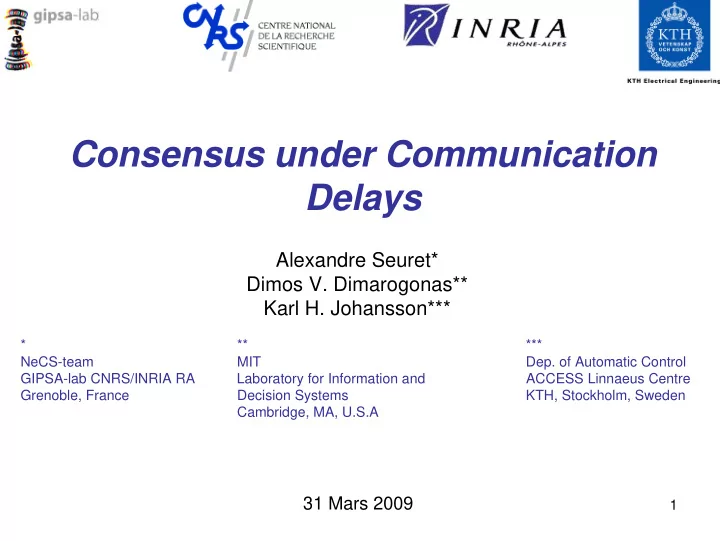

Consensus under Communication Delays Alexandre Seuret* Dimos V. Dimarogonas** Karl H. Johansson*** * ** *** NeCS-team MIT Dep. of Automatic Control GIPSA-lab CNRS/INRIA RA Laboratory for Information and ACCESS Linnaeus Centre Grenoble, France Decision Systems KTH, Stockholm, Sweden Cambridge, MA, U.S.A 31 Mars 2009 1
Introduction • Decentralized consensus control of multi-agent systems: agents aim at attaining a common value of some value function with limited information on the other agents’s goals/states. • Applications: multi-robot systems, distributed estimation and filtering in networked systems. Influence of the communication network on the consensus control: 2 Communication delays
Outline 1) Problem formulation 2) Model transformation 3) Stability analysis a) Existence of a consensus b) Arbitrary networks c) Symmetric networks 4) Discussions on the consensus equilibrium 5) Example 6) Conclusion & Perspectives 3
1. Problem formulation Introduction of communication delays…Where? τ 0 τ τ 2 2 [Olfati-Saber et al ,04 07], [Olfati-Saber et al ,07], 1 1 … [Moreau, 04,05],... 5 5 3 4 3 4 A: Adjacency matrix Δ : Diagonal matrix Laplacian matrix Disturbance due to L=-( Δ -A) : Laplacian the delay + Conserve averaging properties + Realistic setup - Not realistic in case of unknown delays, - Does not (always?) conserve aver. prop. 4 packet losses, samplings,...) [Olfati-Saber et al, 07]
1. Problem formulation Delays & Time-delay systems x x Delay h t t • Time-delay system or hereditary system: Systems where the evolution depends not only on the current state but also on a part of its past. • Fonctionnal differential equations Infinite dimension � Initial conditions are taken over an interval � Infinite number of roots 5
1. Problem formulation: 0 τ 2 Assumptions on the multi-agent set: 1 A1. Arbitrary connected graph 5 3 4 A2. All com. delays are equal and constant A3. The diagonal components of L are equal (arbitrary network) Problems to solve: P1. Analytic expression of the agreement P2. Convergence 6
2. Model transformation An appropriate representation: Lemma 1: Model transformation (1) (2) (in the case of symmetric graphs, B can be diagonal) Proof: 1) Eigenvalue decomposition of the laplacian matrix 2) 3) 7
3. Stability analysis a) Existence of a consensus: Stability and limit of (2) Lemma 2: Proof: 1. Consider the Laplace transform of 2. Characteristic equation : s solution and (2) has stable solution 3. Final limit theorem. 8
9 b) Arbitrary networks: Consensus stability: 3. Stability analysis Theorem 1:
3. Stability analysis b) Arbitrary networks: Proof: (1) 1) (2) 2) Consider the LKF : (Stability of TDS [Niculescu, 2003], Corollary 5.5, pp222) If the conditions of theorem 1 are satisfied, then 3) Lemma 2: 4) 10
3. Stability analysis c ) symmetric networks: Theorem 2: Proof: 1. Symmetric communication graph L is symmetric B is diagonal (1) (2) 2. Characteristic equation of (1): s solution and (1) has asymp. stable solution Horn and Johnson, 1987 3. Application of Lemma 2 as previously 11
4. Discussions on the consensus equilibrium The consensus value is given by: Depends on the delay and on the initial conditions over the delay interval: Two corollaries: Cor.1: Consider initial conditions: Cor 2: Consider initial conditions: Then: Then : Attenuation Non delayed case Event Event Dist. Control Dist. Control Transmission Transmission Reception Reception Time Time 12 - τ 0 τ - τ 0 τ
3. Convergence rate : c) Main result Theorem 2: Exponential convergence of the set multi-agent: Proof: Based on L-K theory and exponential stability [Seuret et al, 04] Precision on the case of symmetric communication graph 13
5. Example Convergence and attenuation 1 1 1 2 2 2 1 2 4 3 4 3 4 3 4 3 Event Event Dist. Control Dist. Control Communication Communication Reception Reception Time Time - τ - τ 0 0 τ τ Event Event Event τ =0.6 , Cor. 2 Dist. Control Dist. Control Dist. Control Communication Communication Communication Reception Reception Reception Time Time Time - τ - τ 0 0 τ τ 14
5. Example Convergence and attenuation 1 1 1 1 2 2 2 2 4 3 4 3 4 3 4 3 τ =0,1 Event Event Dist. Control Dist. Control τ =0.6 Communication Communication Reception Reception Time Time - τ - τ 0 0 τ τ τ= 1.2 Event Event Event τ =0.6 , Cor. 2 Dist. Control Dist. Control Dist. Control τ =0.6 Communication Communication Communication Reception Reception Reception Time Time Time - τ - τ 0 0 τ τ 15
16 τ =0.1 τ =0.6 τ =0 20 18 16 14 12 10 x 8 6 4 Motion in a 2D plan 2 0 15 10 5 0 -5 y 3 2 5. Example 1 4
4. Example Convergence rate τ =0,1 , Cor. 1 τ =0.6 , Cor. 1 τ= 2 , Cor. 1 τ =0.6 , Cor. 2 17
6. Conclusion and perspectives Summary: • Analysis of consensus stability under constant communication delay � Model transformation � Time-delay systems theory • Influence of the initial conditions and the delay • Study of the convegence rate of a consenus On going work and possible extensions: • Delay-independent stability criteriafor arbitrary networks • To a more realistic Setup… � Relaxation of initial restrictions � Heterogenous communication delays � Time-varying delays (including PL, Samplings,…) 18
Some references R.A. Horn and C.R. Johnson, Matrix analysis , Cambridge, UK Cambridge Univ. Press, 1987. L. Moreau, Stability of continuous-time distributed consensus algorithms , 43rd IEEE Conference on Decision and Control,2004. L. Moreau, , Stability of multi-agent systems with time-dependent communication links , IEEE Trans. on Automatic Control 50 (2005), no. 2, 169–182. R. Olfati-Saber, A. Fax, and R.M. Murray, Consensus and cooperation in networked multi-agent systems , Proceedings of the IEEE 95 (2007), no. 1, 215–233. R. Olfati-Saber and R.M. Murray, Consensus problems in network of agents with switching topology and time delays , IEEE Trans. on Automatic Control 49 (2004), no. 9. 19
Recommend
More recommend